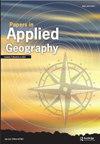Modeling the Vulnerability of Livelihood Systems to Drought along Livelihood Zones in the Northwestern Escarpment of the Ethiopian Rift Valley
Q2 Social Sciences
引用次数: 2
Abstract
Abstract Drought is becoming a common problem for farmers in the Northwestern Escarpment Ethiopian Rift Valley’s three studied livelihood zones (LZs). Droughts wreaked havoc on the community’s livelihood systems regularly. It lefts the community food insure and repeatedly disturbs their ecosystems. As a result, the current study used meteorological, spatial, and socioeconomic data from the area to assess the community’s drought vulnerability. Each variable of drought vulnerability was normalized as proxy indicators to calculate exposure, sensitivity, and adaptive capacity indexes. From the results, the Raya valley livelihood zone (RVLZ) is relatively more drought vulnerable (0.65) than the Tsirare catchment livelihood zone (TCLZ) (0.63) and Alagie-Ofla livelihood zones (ALOFLZ) (0.60). The RVLZ has a less adaptive capacity than ALOFLZ but more susceptibility and higher exposures to drought risks than the two LZs. Besides, the TCLZ has less adaptive capacity than the two livelihood zones, with more vulnerability and exposure to drought risks than ALOFLZ. The highest levels of exposition and susceptibility synergy with low resilience have aggravated the vulnerability to drought in all study LZs. Livelihood zone-based interventions and climate-smart farming are thus necessary for all LZs to reduce possible drought risks and transfer vulnerable communities into high adaptive capacities.埃塞俄比亚大裂谷西北悬崖生计区生计系统对干旱脆弱性的模拟
干旱正成为西北悬崖埃塞俄比亚大裂谷三个生计区(LZs)农民面临的普遍问题。干旱经常对社区的生计系统造成严重破坏。它让社区的食物没有保障,并不断扰乱他们的生态系统。因此,目前的研究使用了该地区的气象、空间和社会经济数据来评估社区的干旱脆弱性。将干旱易损性各变量归一化为代理指标,计算暴露度、敏感性和适应能力指标。结果表明,Raya流域生计区(RVLZ)相对于Tsirare流域生计区(TCLZ)(0.63)和Alagie-Ofla生计区(ALOFLZ)(0.60)更为干旱脆弱。RVLZ的适应能力低于ALOFLZ,但对干旱风险的敏感性和暴露程度高于两个lzz。此外,与两个生计区相比,TCLZ的适应能力较弱,脆弱性和干旱风险均高于ALOFLZ。高暴露和敏感性协同效应与低恢复力加剧了所有研究区对干旱的脆弱性。因此,以生计区为基础的干预措施和气候智能型农业对于所有LZs来说都是必要的,以减少可能的干旱风险,并将脆弱社区转变为具有高适应能力的社区。
本文章由计算机程序翻译,如有差异,请以英文原文为准。
求助全文
约1分钟内获得全文
求助全文

 求助内容:
求助内容: 应助结果提醒方式:
应助结果提醒方式:


